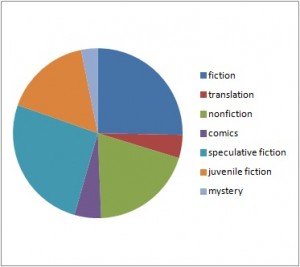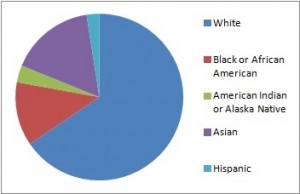For 2014, I set myself a goal of reading one book by a person of color out of every five books I read altogether. That number was on the low side because I’d never done this sort of experiment before, and I didn’t want to set myself up for failure. As many people (Amanda of Book Riot, recently) have noted, the book world is remarkably white, and it’s a cycle that reinforces itself. If — like many bloggers these days! — you embark on a project that necessitates your seeking out books by nonwhite authors, it can be tricky to get recommendations from the traditional newspaper and online book review sources.
Here are my stats, in the end. Note that I didn’t include romance novels, rereads, or academic nonfiction on this spreadsheet, unless I ended up blogging about them. There’s not a great reason for this, except that those categories of books feel like filling up my gas tank, rather than actually driving. The comfort books fill me up when I am low on calm, and the nonfiction when I am low on, I suppose, new facts for my facts-greedy brain. Because of the demographic makeup of the romance world, the children’s section of my childhood library, and academia, respectively, I’d have ended up with a lot more white folks on my list if I’d included those categories. So with that in mind, here’s the pie chart!
I used the US Census Bureau racial choices, for lack of a better option. As you can see, it worked out to about two-thirds white, one-third not white, or in other words: Better than expected! I think next year I’ll aim at 35% non-white authors, and I’m also going to try to do 40% non-American authors — which obviously will include some overlap. We’ll see how it goes.

Since I haven’t tracked my reading in a systematic way in years past, I can’t say for certain that reading more diversely had zero impact on my genre choices. But its impact can’t have been very big. I read roughly equivalent amounts of nonfiction and YA books, with each of those categories accounting for close to 20% of my total. I read a smallish number of mysteries, comics, and books in translation (and obviously, some books fell into more than one category). Speculative fiction and fiction not otherwise classified were the biggest chunks of the pie, about 25% each.
I probably read more nonfiction this year than in years past, but apart from that, this is the exact pie chart I’d expect from every year of reading I’ve ever had. Aarti, who is mindful of diversity in reading and an excellent source for diverse book recommendations, has said over and over again that reading diversely may require you to change your book-finding habits, but it will certainly not make you change your book-reading habits.
If there has been a change in my book-finding habits, it’s this: As I read through my blogroll or flip through the New York Times, there are some books that scream my name. They are spooky books, or books about the aftershocks of colonialism, or books about culpability, or books with unreliable narrators, or ideally they are all of those things at once. I will read those books regardless of the demographic into which their authors fall. And then there are some books that stick out their tongues and turn away. Those are multigenerational family sagas or stories about doomed love or the tale of an angry writer who’s not getting the sex he feels he deserves. I will ignore those ones unless someone in the blogosphere says “JENNY READ THIS,” a thing that happened this year with Maggie Stiefvater to startling effect. Where these books are concerned, nothing has changed.
In the middle category, books that neither scream for notice nor try to get away, but books that quietly say “ahem,” this is where my habits have changed, a little. Before, I wrote down all the books that said “ahem” at a certain volume. Now, books by white authors have to say it a little louder than books by authors of color. It’s a tiny corrective, particularly when you set it against the snowy whiteness of the publishing industry that produces most of these books, and of the journalism industry that brings them to our attention.
The effect of this is that when I’m not exactly sure what I’m in the mood for, I don’t have a ton of familiar-sounding books on my TBR list. You know the ones? The ones you added to your TBR list in the same way that Netflix adds things to your recommendations: You liked that so you might like this. You liked The Secret History, and this is another book about rich kids doing dramatic things at boarding schools. These are the books I’m no longer making note of, when they’re by white authors. I’m giving their spots away to different voices. It’s salutary, I think, to defamiliarize, to remember that the world in which you feel comfortable isn’t the only version of the world on offer.Do you track the demographics of your reading? Are you setting demographic goals for 2015?
